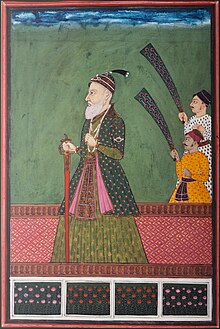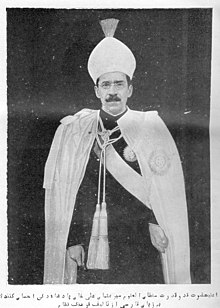
Back دولة حيدر آباد Arabic Heydərabad nizamlığı AZ হায়দ্রাবাদ রাজ্য Bengali/Bangla Estat de Hyderabad Catalan Hajdarábád (stát) Czech Hyderabad (fyrstestat) Danish Hyderabad (Staat) German Hajderabado (princlando) EO Hyderabad (estado) Spanish Hyderabad (estatua) EU
Hyderabad State | |||||||||
|---|---|---|---|---|---|---|---|---|---|
| 1724–1948 | |||||||||
| Motto: Al Azmat Allah ("Greatness belongs to God") Ya Osman ("Oh Osman") | |||||||||
 Hyderabad (dark green) and Berar Province, not a part of Hyderabad State but also the Nizam's Dominion between 1853 and 1903 (light green) | |||||||||
| Status | Vassal state of the Mughal Empire (de jure, 1724–1858) Semi-independent under British protection (1798–1858) Princely state of India (1858–1947) Unrecognised independent state (1947–1948) | ||||||||
| Capital | Aurangabad (1724–1763) Hyderabad (1763–1948) | ||||||||
| Official languages | Persian (Court and revenue 1724–1886) and Hindustani (dynastic)[1]
Hindustani (For Court and revenue from 1886–1948) | ||||||||
| Common languages | Telugu (48.2%) Marathi (26.4%) Kannada (12.3%) Deccani Urdu (10.3%)[2][3] | ||||||||
| Religion | Hinduism (81%) Islam (13%)[4] Christianity and others (6%) (spread among Anglo-Indian population expanding to Secunderabad and Hyderabad) [5] | ||||||||
| Government | Absolute Monarchy | ||||||||
| Nizam | |||||||||
• 1724–1748 | Nizam-ul-Mulk, Asaf Jah I (first) | ||||||||
• 1911–1948 | Osman Ali Khan, Asaf Jah VII (last) | ||||||||
| Prime Minister | |||||||||
• 1724–1730 | Iwaz Khan (first) | ||||||||
• 1947–1948 | Mir Laiq Ali (last) | ||||||||
| Historical era | . | ||||||||
• Established | 31 July 1724 | ||||||||
| 1946 | |||||||||
| 18 September 1948 | |||||||||
| Area | |||||||||
| 1941[7] | 214,187 km2 (82,698 sq mi) | ||||||||
| Population | |||||||||
• 1941[7] | 16,338,534 | ||||||||
| Currency | Hyderabadi rupee | ||||||||
| |||||||||
| Today part of | India | ||||||||
| Princely state |
|---|
| Individual residencies |
| Agencies |
|
| Lists |
Hyderabad State (ⓘ)[8] was a princely state in the Deccan region of south-central India with its capital at the city of Hyderabad. It is now divided into the present-day state of Telangana, the Kalyana-Karnataka region of Karnataka, and the Marathwada region of Maharashtra in India.
The state was ruled from 1724 to 1948 by the Nizam, who was initially a viceroy of the Mughal empire in the Deccan. Hyderabad gradually became the first princely state to come under British paramountcy signing a subsidiary alliance agreement. During the British rule in 1901, the state had a revenue of ₹4,17,00,000.[9] The native inhabitants of Hyderabad State, regardless of ethnic origin, are called "Mulki" (countryman), a term still used today.[10][11]
The dynasty declared itself an independent monarchy during the final years of the British Raj. After the Partition of India, Hyderabad signed a standstill agreement with the new dominion of India, continuing all previous arrangements except for the stationing of Indian troops in the state. Hyderabad's location in the middle of the Indian Union, as well as its diverse cultural heritage led to India's annexation of the state in 1948.[12] Subsequently, Mir Osman Ali Khan, the seventh Nizam, signed an instrument of accession, joining India.[13]


- ^ Tariqh Rahman (2008). Urdu In hyderabad. Department of Languages and cultures in Asia. p. 36.
The Nizams from Mīr Qamruíd-Dīn Khān (1724-48) until the sixth ruler of the house Mīr Maḥbūb ʿAlī Khān (1869-1911) used Persian as their court language, in common with the prevailing fashion of their times, though they spoke Urdu at home.
- ^ Beverley, Hyderabad, British India, and the World 2015, p. 110.
- ^ Benichou, Autocracy to Integration 2000, p. 20.
- ^ MiO'Dwyer, Michael (1988), India as I Knew it: 1885–1925, Mittal Publications, pp. 137–, GGKEY:DB7YTGYWP7W
- ^ Smith 1950, pp. 27–28.
- ^ Benichou, Autocracy to Integration 2000, Chapter 7: "'Operation Polo', the code name for the armed invasion of Hyderabad"
- ^ a b Husain, Mazhar (1947). Census Of India 1941 Vol-xxi H.e.h. The Nizams Dominions (hyd State).
- ^ Ali, Cherágh (1886). Hyderabad (Deccan) Under Sir Salar Jung. Printed at the Education Society's Press.
- ^ "Imperial Gazetteer2 of India, Volume 13, page 277 – Imperial Gazetteer of India – Digital South Asia Library".
- ^ Leonard, Karen Isaksen (2007). Locating Home: India's Hyderabadis Abroad. Stanford University Press. ISBN 978-0-8047-5442-2.
- ^ Reddy, Deepika (4 March 2019). "The 1952 Mulki agitation". Telangana Today. Archived from the original on 11 December 2019. Retrieved 11 December 2019.
- ^ Sherman, Taylor C. (2007), "The integration of the princely state of Hyderabad and the making of the postcolonial state in India, 1948–56" (PDF), The Indian Economic and Social History Review, 44 (4): 489–516, doi:10.1177/001946460704400404, S2CID 145000228
- ^ Chandra, Mukherjee & Mukherjee 2008, p. 96.

